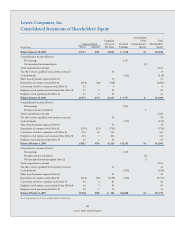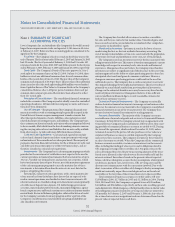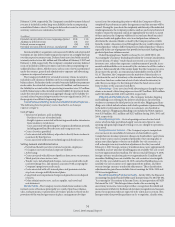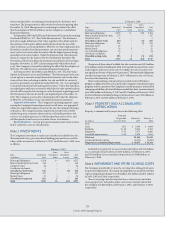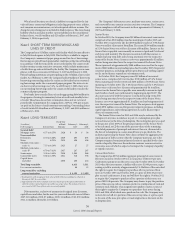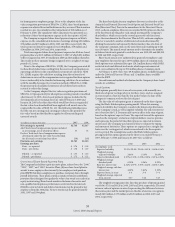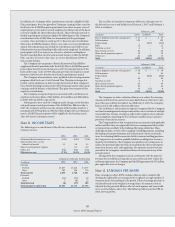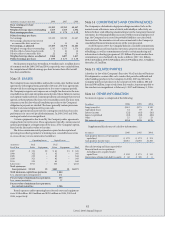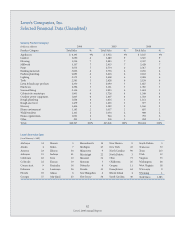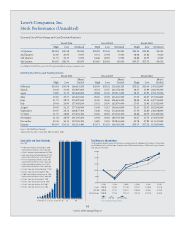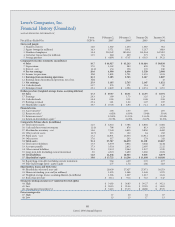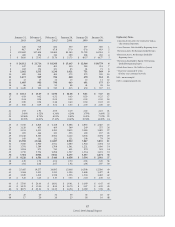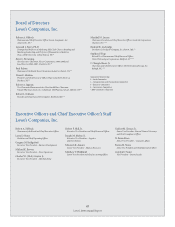Lowe's 2006 Annual Report Download - page 44
Download and view the complete annual report
Please find page 44 of the 2006 Lowe's annual report below. You can navigate through the pages in the report by either clicking on the pages listed below, or by using the keyword search tool below to find specific information within the annual report.
40
Lowe’s 2006 Annual Report
In addition, the Company oers a performance match to eligible 401(k)
Plan participants, based on growth of Company earnings before taxes for
the scal year. 401(k) Plan participants must have three or more years of
employment service and be actively employed on the last day of the scal
year to be eligible for the performance match. e performance match is
funded in participant accounts in April of the following year. e Company’s
contributions to the 401(k) Plan vest immediately in the participant
accounts. Once participants reach age 59 ½, they may elect to withdraw
their entire 401(k) Plan balance. is is a one-time, in-service distribution
option. Participants may also withdraw contributions and rollover con-
tributions for reasons of hardship while still actively employed. In addition,
participants with 20 or more years of service, who have an Employee
Stock Ownership Plan carryforward account balance within the 401(k)
Plan, can elect to receive a one-time, in-service distribution of 50% of
this account balance.
e Company also maintains a Benet Restoration Plan (BRP) to
supplement benets provided under the 401(k) Plan to 401(k) Plan partici-
pants whose benets are restricted as a result of certain provisions of the
Internal Revenue Code of 1986. is plan provides for employer contri-
butions in the form of a baseline match and a performance match.
e Company also maintains a non-qualied deferred compensation
program called the Lowe’s Cash Deferral Plan. is plan is designed to
permit certain employees to defer receipt of portions of their compensa-
tion, thereby delaying taxation on the deferral amount and on subsequent
earnings until the balance is distributed. is plan does not provide for
employer contributions.
e Company recognized expense associated with contributions to
employee retirement plans of $42 million, $136 million and $68 million
in 2006, 2005 and 2004, respectively.
Subsequent to year-end, the Company made changes to the baseline
and performance match provisions of the 401(k) Plan. Eective May 5,
2007, the Company will increase the amount of the baseline match to a
maximum of 4.25% (up from 2.25%) but will no longer oer a performance
match. 401(k) Plan participants will be eligible for the baseline match
aer 180 days of continuous service.
Note 11 INCOME TAXES
e following is a reconciliation of the eective tax rate to the federal
statutory tax rate:
2006 2005 2004
Statutory federal income tax rate 35.0% 35.0% 35.0%
State income taxes, net of
federal tax benet 3.3 3.6 3.5
Share-based payment expense – 0.1 0.2
Other, net (0.4) (0.2) (0.2)
Eective tax rate 37.9% 38.5% 38.5%
Components of Income Tax Provision
(In millions) 2006 2005 2004
Current
Federal $1,657 $1,514 $ 1,077
State 242 254 174
Total current 1,899 1,768 1,251
Deferred
Federal (11) (31) 80
State 5 (6) 22
Total deferred (6) (37) 102
Total income tax provision $1,893 $1,731 $1,353
e tax eect of cumulative temporary dierences that gave rise to
the deferred tax assets and liabilities at February 2, 2007, and February 3,
2006, is as follows:
February 2, 2007
(In millions) Assets Liabilities Total
Excess property and store closing costs $ 17 $ – $ 17
Self-insurance 129 – 129
Depreciation – (837) (837)
Rent 13 – 13
Vacation accrual 8 – 8
Sales returns reserve 22 – 22
Share-based payment expense 59 – 59
Other, net 44 (29) 15
Total $292 $(866) $(574)
February 3, 2006
(In millions) Assets Liabilities Total
Excess property and store closing costs $ 19 $ – $ 19
Self-insurance 81 – 81
Depreciation – (804) (804)
Rent 26 – 26
Vacation accrual 6 – 6
Sales returns reserve 44 – 44
Share-based payment expense 40 – 40
Other, net 19 (11) 8
Total $235 $(815) $(580)
e Company records a valuation allowance to reduce the carrying
amount of deferred tax assets if it is more likely than not that all or a por-
tion of the asset will not be realized. As of February 2, 2007, the Company
had recorded a $4 million valuation allowance.
e tax balances and income tax expense recognized by the Company
are based on management’s interpretation of the current tax laws of multiple
tax jurisdictions. Income tax expense reects the Company’s best estimates
and assumptions regarding the level of future taxable income and inter-
pretation of current tax statutes.
e Company believes that its tax positions are consistent with applicable
tax laws and that they are supportable. However, management believes that
certain positions are likely to be challenged by taxing authorities. ese
challenges include a review of the Company’s tax ling positions, including
the timing and amount of income and deductions in various tax jurisdic-
tions. In evaluating liabilities associated with its various tax ling positions,
the Company has accrued for probable liabilities resulting from tax assess-
ments by tax authorities. e Company records these tax contingencies to
address the potential exposures that can result from the diverse interpreta-
tions of tax statutes, rules and regulations. e amounts accrued were not
material to the Company’s consolidated nancial statements in any of the
years presented.
During 2006, the Company reached a settlement with the Internal
Revenue Service (IRS) covering the tax years 2002 and 2003. Under the
settlement agreement, the Company paid the IRS approximately $17 million,
plus applicable interest charges.
Note 12 EARNINGS PER SHARE
Basic earnings per share (EPS) excludes dilution and is computed by
dividing the applicable net earnings by the weighted-average number of
common shares outstanding for the period. Diluted earnings per share is
calculated based on the weighted-average shares of common stock as
adjusted for the potential dilutive eect of stock options and convertible
notes as of the balance sheet date. e following table reconciles EPS for
2006, 2005 and 2004:


